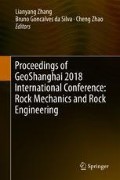Abstract
This paper examines the assumption of pseudo-steady state inter-porosity mass exchange in dual porosity models of fractured rock. Models of this type rely on the assumption that a pseudo-steady pore pressure distribution prevails in the porous matrix at all times, thereby neglecting transient pressure gradients. The rate of inter-porosity mass exchange is then conveniently expressed as a linear function of the difference between the average pore pressures in the fracture and matrix domains. Whilst providing a relatively simple description of mass exchange, the accuracy of this approach has been debated and it is strictly only valid once the pressure front due to changing conditions in the fracture network reaches the centre of the matrix. The aim of this paper is to compare the pseudo-steady state model of mass exchange with an explicit model of diffusive flow into a rock matrix with parallel-plate geometry. Since the mass exchange coefficient is sometimes described as a function of matrix block geometry and effective diffusivity, an attempt is made to adopt this approach before curve fitting is used. The results indicate that the adopted function underestimates the mass exchange rate compared to the benchmark, although the pseudo-steady state model can provide close agreement if curve fitting is used. It is concluded that the assumption of pseudo-steady state mass exchange may be valid only for cases where calibration of the linear coefficient is possible. Constitutive relationships describing the coefficient should be approached with care, with the possible exception of those considering some level of transiency.
Access this chapter
Tax calculation will be finalised at checkout
Purchases are for personal use only
References
Bear, J.: Modeling flow and contaminant transport in fractured rocks. In: Bear, J., Tsang, C.-F., de Marsily, G. (eds.) Flow and Contaminant Transport in Fractured Rock, pp. 1–38. Academic Press, Inc., San Diego (1993)
Therrien, R., Sudicky, E.A.: Three-dimensional analysis of variably-saturated flow and solute transport in discretely-fractured porous media. J. Contam. Hydrol. 23(1–2), 1–44 (1996)
Samardzioska, T., Popov, V.: Numerical comparison of the equivalent continuum, non-homogeneous and dual porosity models for flow and transport in fractured porous media. Adv. Water Resourc. 28(3), 235–255 (2005)
Hosking, L.J., Thomas, H.R., Sedighi, M.: A dual porosity model of high pressure gas flow for geoenergy applications. Can. Geotech. J. (2017, submitted)
Xu, T.F., Pruess, K.: Modeling multiphase non-isothermal fluid flow and reactive geochemical transport in variably saturated fractured rocks: 1. Methodology. Am. J. Sci. 301(1), 16–33 (2001)
Gerke, H.H., van Genuchten, M.T.: A dual-porosity model for simulating the preferential movement of water and solutes in structured porous-media. Water Resourc. Res. 29(2), 305–319 (1993)
Ma, D.H., Shao, M.G.: Simulating infiltration into stony soils with a dual-porosity model. Eur. J. Soil Sci. 59(5), 950–959 (2008)
Wu, Y., et al.: Dual poroelastic response of a coal seam to CO2 injection. Int. J. Greenhouse Gas Control 4(4), 668–678 (2010)
Chen, D., et al.: Modeling and simulation of moisture effect on gas storage and transport in coal seams. Energy Fuels 26(3), 1695–1706 (2012)
Hassanzadeh, H., Pooladi-Darvish, M.: Effects of fracture boundary conditions on matrix-fracture transfer shape factor. Transp. Porous Media 64(1), 51–71 (2006)
Lemonnier, P., Bourbiaux, B.: Simulation of naturally fractured reservoirs. state of the art-Part 2–matrix-fracture transfers and typical features of numerical studies. Oil Gas Sci. Technol.–Revue de l’Institut Français du Pétrole 65(2), 263–286 (2010)
Thomas, H.R., He, Y.: Modelling the behaviour of unsaturated soil using an elasto-plastic constitutive relationship. Géotechnique 48(5), 589–603 (1998)
Sedighi, M., Thomas, H.R., Vardon, P.J.: Reactive transport of chemicals in unsaturated soils: numerical model development and verification. Can. Geotech. J. 53(1), 162–172 (2016)
Cussler, E.L.: Diffusion: Mass Transfer in Fluid Systems, 2nd edn. Cambridge University Press, Cambridge (1997)
Millington, R., Quirk, J.P.: Permeability of porous solids. Trans. Faraday Soc. 57(8), 1200–1207 (1961)
Gwo, J., et al.: A multiple-pore-region concept to modeling mass transfer in subsurface media. J. Hydrol. 164(1–4), 217–237 (1995)
Schwartz, R.C., Juo, A.S.R., McInnes, K.J.: Estimating parameters for a dual-porosity model to describe non-equilibrium, reactive transport in a fine-textured soil. J. Hydrol. 229(3–4), 149–167 (2000)
Laubach, S.E., et al.: Characteristics and origins of coal cleat: a review. Int. J. Coal Geol. 35(1–4), 175–207 (1998)
Author information
Authors and Affiliations
Corresponding author
Editor information
Editors and Affiliations
Rights and permissions
Copyright information
© 2018 Springer Nature Singapore Pte Ltd.
About this paper
Cite this paper
Hosking, L.J., Thomas, H.R. (2018). An Investigation of the Pseudo-steady State Approach to Modelling Inter-porosity Flow in Fractured Geomaterials. In: Zhang, L., Goncalves da Silva, B., Zhao, C. (eds) Proceedings of GeoShanghai 2018 International Conference: Rock Mechanics and Rock Engineering. GSIC 2018. Springer, Singapore. https://doi.org/10.1007/978-981-13-0113-1_4
Download citation
DOI: https://doi.org/10.1007/978-981-13-0113-1_4
Published:
Publisher Name: Springer, Singapore
Print ISBN: 978-981-13-0112-4
Online ISBN: 978-981-13-0113-1
eBook Packages: Earth and Environmental ScienceEarth and Environmental Science (R0)

